Canadian Warplanes 6a: Canadair F-86 Sabre Squadrons
Canadair F-86 Sabre Squadrons

(DND Photo via James Craik)
Canadair F-86 Sabre Mk. 5 formation, over Europe. (Serial No. 23310), No. 430 Squadron, coded BH, (Serial No. 23226), No. 416 Squadron, coded AS, (Serial No. 23057), and (Serial No. 23159), 1955.
The North American F-86 Sabre was first flown on October 1, 1947, and quickly proved a highly successful design. With the formation of NATO in 1949, the Canadian government made the decision to re-equip the RCAF’s front-line fighter squadrons with modern aircraft and selected the F-86 Sabre. Consequently, an agreement was reached between North American and Canadair Ltd. of Montréal to manufacture 100 F-86As in Canada. After the first prototype, designated F-86 Sabre Mk. 1, Canadair immediately began production in earnest with an improved Mk 2 model. The Mk 2 was essentially an F-86E with an “all flying” tail plane to provide better flying characteristics, as well as a flat windscreen. The next major production model was the Mk 4—which was originally to have been powered by an Orenda-designed engine but, to retain commonality with the F-86E, it also carried the J47-GE-13.
Various design improvements were incorporated throughout the aircraft and 438 Mk 4 Sabres rolled off the assembly lines. The Mk 5 Sabre was the first production model with a Canadian engine, using the Orenda 10 version and rated at 6,355-lb thrust. The bigger Orenda engine necessitated a larger diameter opening in fuselage frames and stronger engine mounts. An important structural modification was the introduction of a fixed leading edge to replace the automatic slats on earlier versions. This change was designed to enhance the high altitude performance of the aircraft. Small wing fences were also introduced at the 70 per cent span position. These modifications were successful, but also resulted in a corresponding decrease in low-speed handling characteristics. After the construction of 370 Mk 5 aircraft, Canadair moved on to the final (and best) version, the Mk 6.
This version carried the two-stage Orenda 14 engine with a 7,275 lb thrust rating. The wing leading slats were re-introduced, while retaining portions of the Mk 5 wing configuration. The Mk 6 therefore acquired superb combat manoeuvring. With this combination of engine and aerodynamics, the Mark 6 was widely regarded as the best “dog-fighter” of its era. The Golden Hawks teams of the RCAF initially flew Mk 5 aircraft, but were soon equipped with the excellent Mk 6 aircraft. (DND)
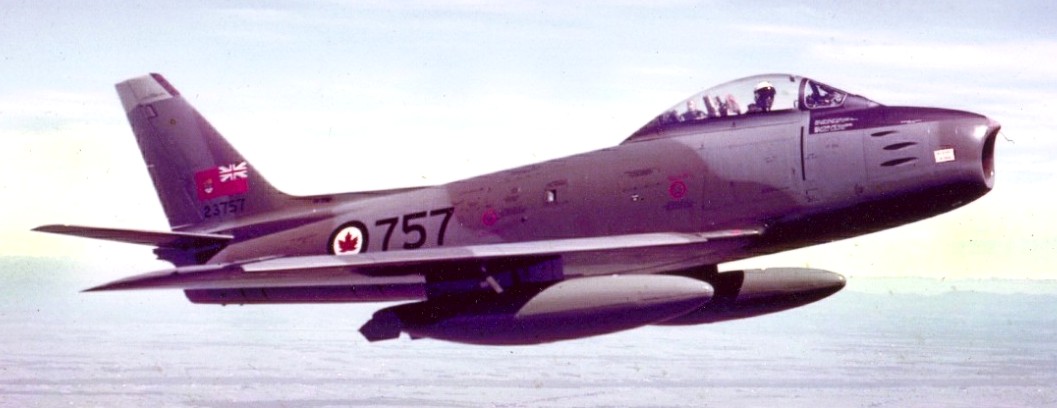
(DND Photo)
Canadair F-86 Sabre Mk. 5 (Serial No. 23757) was the last version, with Avro Orenda 14 engines that served with the RCAF. This Sabre is carrying the camouflage developed for all RCAF European-based operational aircraft. The photo was taken while the aircraft belonged to No. 1 Overseas Ferry Unit (OFU) based at St. Hubert, Quebec, which was formed in 1953 to ferry Sabres and T-33s across the North Atlantic.
A total of 390 Mk.6s went to the RCAF with the majority replacing the existing Canadair Sabre Mk.5s at the Air Division squadrons in West Germany and France. The main air threats to NATO in the 1950s in Central Europe were the early variants of the Soviet MiG- the MiG-15, MiG-17, MiG-19 and MiG-21. Based on the Korean War experience, the selection of the Mk.6 Sabre to provide an effective opposition to the MiG threat proved to be a logical one. Canada's commitment to NATO was to provide 12 squadrons located at four bases – two in France (Marville and Grostenquin) and two in West Germany (Zweibrücken and Baden Soellingen). Initially, the contribution consisted of only Sabre aircraft; however, later it was decided to include the Avro Canada CF-100 aircraft in the defense package to provide a night and all-weather fighter capability.
Though the main use of the Sabre by the RCAF was in Europe, they were also used by RCAF Auxiliary part-time units in Canada, replacing de Havilland Vampire jets. 400 "City Of Toronto" and 411 "County Of York" Squadrons based at RCAF Station Downsview near Toronto, as well as 401 "City Of Westmount" and 438 "City Of Montreal" Squadrons at RCAF Station St-Hubert near Montreal, were equipped with Sabre 5s, as was 442 "City Of Vancouver" Squadron at RCAF Station Sea Island, near Vancouver. (DND)
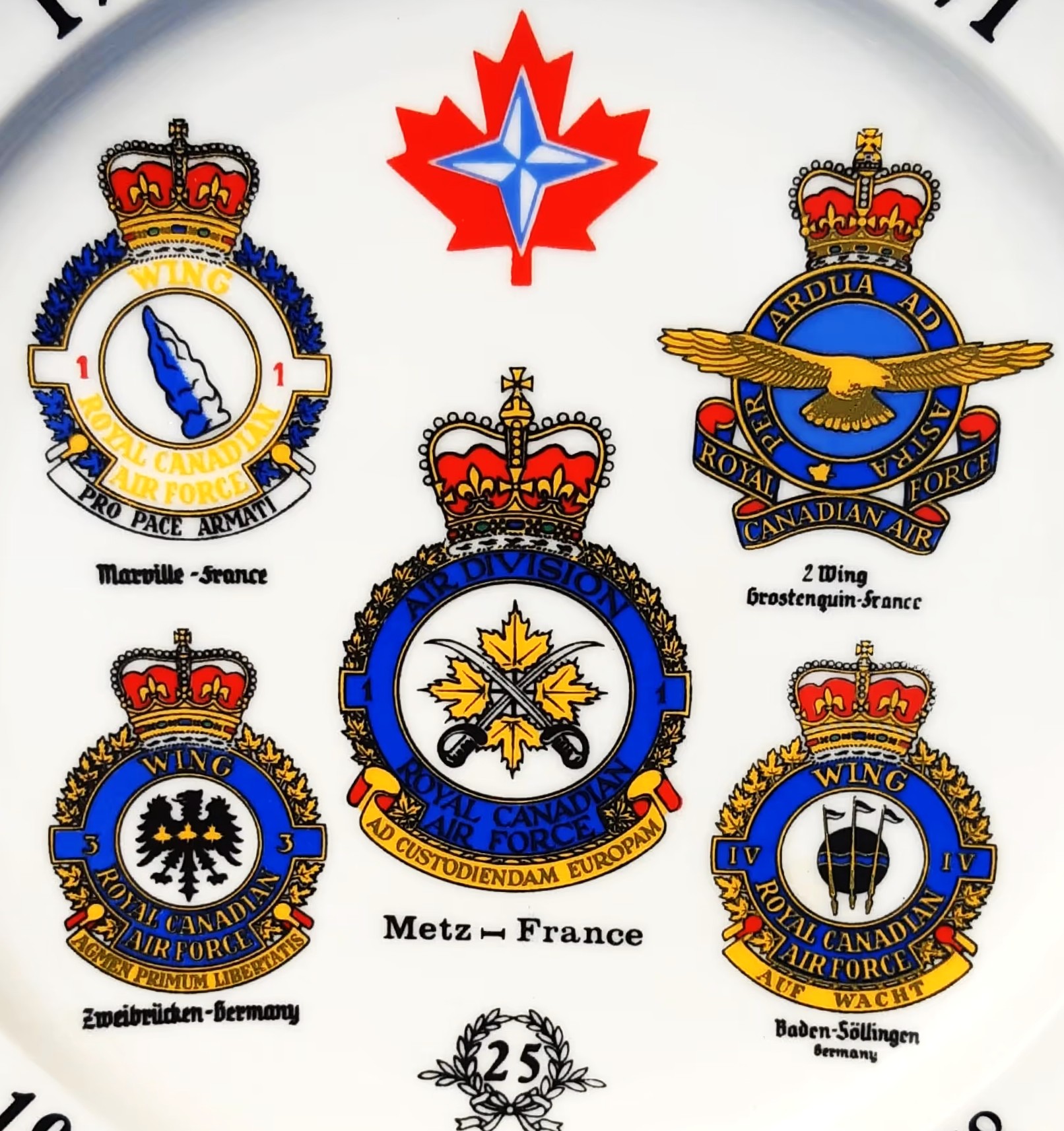
RCAF commemorative plate with the 1 Air Division base crests for France and Germany.
No. 1 Air Division, RCAF (1952-1967)
The division traces its origins to the activation of Headquarters No. 1 Air Division, Royal Canadian Air Force in Paris, France on 1 October 1952. No. 1 Air Division headquarters was relocated to Metz, France in April 1953. No. 1 Air Division was established to meet Canada's NATO air defence commitments in Europe. It consisted of four wings of of three fighter squadrons each for a total of twelve squadrons located at four bases in France and West Germany. These included RCAF Station Marville, No. 1 (F) Wing, and RCAF Station Grostenquin, No. 2 (F) Wing in France, RCAF Station Zweibrücken, No. 3 (F) Wing, and RCAF Station Baden-Soellingen, No. 4 (F) Wing in West Germany.
No. 400 Squadron RCAF
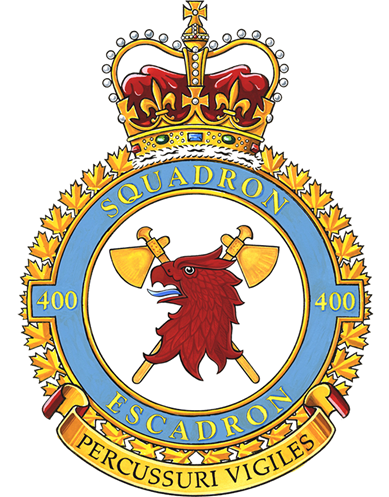
15 Apr 1946. No. 400 (Fighter Bomber) Squadron (Auxiliary)was re-formed at Downsview, Toronto, Ontario, flying North American Harvard Mk. IIBs. At the start of the Cold War the squadron flew the de Havilland DH.100 Vampire Mk. III and then Canadair F-86 Sabre Mk. V.


(militarybruce Photos)
Canadair F-86 Sabres, No. 400 Squadron.
No. 401 Squadron RCAF
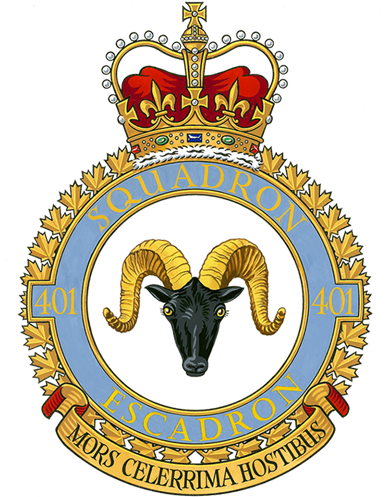
No. 401 "City of Westmount" (Fighter) Squadron (Auxiliary) was formed at Montreal, Quebec, on 15 Apr 1946, flying de Havilland Vampire and Canadair F-86 Sabre Mk. 5 fighters from Oct 1956 to Oct 1958. No. 401 Squadron was reassigned to a light transport and emergency rescue role.

(DND Photo via James Craik)
Canadair F-86 Sabre Mk. 5 (Serial No. 23315), coded AB, No. 401 Squadron (Auxilliary), St. Hubert, Quebec, Oct 1956 to Nov 1958.

(DND Photo)
Canadair F-86 Sabre Mk. 5 (Serial No. 23209), coded AB, No. 401 Squadron (Auxiliary), based at RCAF Station St. Hubert Quebec, over St-Laurence River, c1957-58.

(DND Photo via Francois Dutil)
Canadair F-86 Sabre Mk. 5 (Serial No. 23047), coded AB, No. 401 Squadron (Auxiliary), St. Hubert Quebec, Oct 1956 to Nov 1958.
No. 410 Squadron RCAF
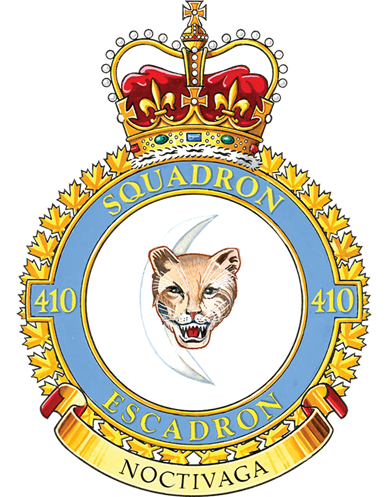
No. 410 Tactical Fighter Operational Training Squadron, nicknamed the "Cougars", is currently located at CFB Cold Lake, Alberta. The squadron was formed during the Second World War as an RCAF squadron under the RAF, at RAF Ayr, near Prestwick, Scotland. No. 410 Squadron was the third RCAF night fighter squadron to be formed and was equipped with the Boulton Paul Defiant. In May 1942 these were replaced by the Bristol Beaufighter. The first official sortie of No. 410 Squadron was from RAF Drem, East Lothian, Scotland, on the night of 4 June 1942, when twelve Bristol Beaufort crews took off. In October 1944, the Squadron was re-equipped with de Havilland Mosquito Mk. IIs, with which the first victory for the squadron was claimed/. It went on to become the top-scoring night fighter squadron in the RAF Second Tactical Air Force during the period between D-Day and VE-Day.
No. 410 Squadron supported the Allied forces during the Normandy Landings and the Battle of the Bulge, flew nightly patrols during this time and many of its pilots gained ace status. Two members of No. 410 Squadron, Flight Lieutenant (F/L) Currie and Flying Officer (F/O) Rose, were the first members of the RCAF to see the German V-2 rocket in flight. The squadron flew 2,972 sorties and accumulated 28,150 hours of flight time. By the end of the war, members of the squadron had claimed 75 3⁄4 75 3⁄4 enemy aircraft destroyed, 2 probably destroyed, and 9 damaged. Operational losses included 17 aircraft and personnel losses included 32 aircrew, of whom 10 were killed, 20 presumed dead, and two were made prisoners of war. Non-operational casualties included 14 aircraft lost and 30 personnel, of whom 29 were killed, 1 injured.
The Squadron moved through a series of RAF bases, but by 5 April 1945 the Cougars were back at RAF Amiens-Glisy. The final move of the war occurred on 9 June 1945, when the squadron relocated to RAF Gilze-Rijen in the Netherlands. The squadron was disbanded in June 1945.
No. 410 Squadron was reactivated on 1 December 1946 as an Air Defence squadron flying de Havilland Vampire F.3 aircraft, and was re-formed from a defence role into that of a fighter role at St. Hubert near Montreal, Quebec on 1 December 1948. From May 1949 to August 1951, the Blue Devils aerobatics team formed, to demonstrate the abilities of the new Vampire aircraft at formation flying. The squadron later converted to the Canadair F-86 Sabre and was deployed to Europe, initially flying from RCAF Station North Luffenham in the UK, and then at RCAF Station Marville (No. 1 (Fighter) Wing) in France. The squadron had been the first regular force fighter unit to fly the Vampire aircraft and was the first to fly the Sabre and the first to join No. 1 (Fighter) Wing of No. 1 Air Division in Europe.
When No. 445 All Weather (Fighter) [AW(F)] Squadron arrived from Canada, however, No. 410 Squadron was deactivated at Marville on 1 October 1956 and reactivated as an all-weather fighter squadron at Uplands near Ottawa, Ontario on 1 November of that year, flying Avro CF-100 Canucks. When the CF-100s were removed from service in 1961, the McDonnell CF-101 Voodoo interceptor was introduced for North American air defence. No. 410 Squadron converted to these aircraft and the squadron continued to fly Voodoos until defence cuts led to the squadron being deactivated on 31 March 1964.
In 1968, No. 3 OTU (Operating Training Unit) based at CFB Bagotville was tasked with training pilots and navigators for the three operational RCAF Voodoo squadrons. It was later renamed No. 410 Squadron. No. 410 Squadron moved to CFB Cold Lake, Alberta in 1982, changing aircraft to become the training unit for Canada's then new McDonnell CF-188 Hornet fighter. Currently, No. 410 Tactical Fighter Operational Training Squadron trains between 20 and 22 pilots a year on the Hornet, more than any other RCAF squadron.

(RCAF Photo)
Canadair F-86 Sabre Mk. 2 (Serial No. 19102), coded AM-N, No. 410 Squadron, RCAF Station St. Hubert, Quebec, 17 Aug 1951. This was the first production Sabre by Canadair. This Sabre was serving with Air Defence Command, shortly before deploying to Europe.

(RCAF Photo via Brian Rempel)
Canadair F-86 Sabre Mk. 2 (Serial No. 19141) with No. 410 Squadron, coded AM.


(RCAF Photos)
Canadair F-86 Sabre Mk. 2 (Serial No. 19102), coded AM-N, No. 410 Squadron, RCAF Station St. Hubert, Quebec, 17 Aug 1951. This was the first production Sabre by Canadair. This Sabre is serving with Air Defence Command, shortly before deploying to Europe.

(DND Photo via James Craik)
Canadair F-86 Sabre Mk. 2 (Serial No. 19144), coded AM-T, No. 410 Squadron, in formation.

(DND Photo via Harry Meers)
Canadair F-86 Sabre Mk. 2 (Serial No. 19144), coded AM-T, No. 410 Squadron, in formation.

(DND Photo via Harry Meers)
Canadair F-86 Sabre Mk. 2 (Serial No. 19183).

(John Yoxhall Photo via Al Robb)
Canadair F-86 Sabre Mk. 2 (Serial No. 19159), (Serial No. 19176), and (Serial No. 19180), No. 410 Squadron, coded AM, North Luffenham, England, Dec 1952.

(John Yoxhall Photo via Al Robb)
Canadair F-86 Sabre Mk. 2 (Serial No. 19159) and (Serial No. 19180), No. 410 Squadron, coded AM, North Luffenham, England, Dec 1952.
No. 411 Squadron RCAF
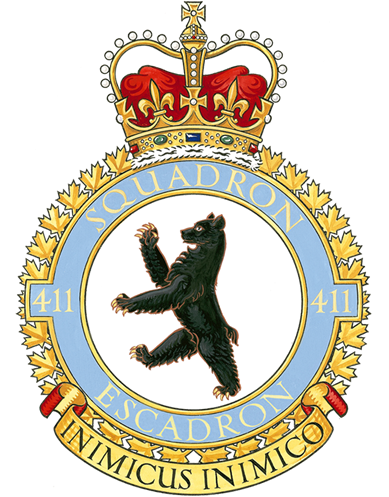
No. 411 "County of York" Squadron (Auxiliary) was was formed at Toronto, Ontario on 1 Oct 1950. The squadron flew Sabres from Oct 1956 to Sep 1958.

(RCAF Photo)
Canadair F-86 Sabre Mk. 5, RCAF (Serial No. 23312), No. 411 "County of York" Squadron (Auxiliary), coded KH, Downsview, Ontario.
No. 413 Squadron RCAF
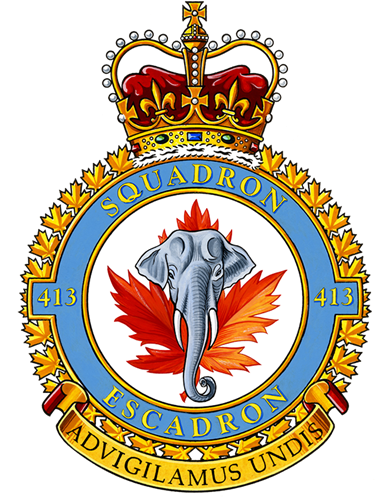
No. 413 Squadron was formed at Stranraer, Scotland on 1 Jul 1941, as the third RCAF squadron attached to RAF Coastal Command and first flying boat General Reconnaissance (G.R.) squadron formed overseas. It was equipped with Consolidated PBY Catalina flying boats. The squadron gained fame for the actions of Squadron Leader Leonard Birchall, who detected a large Japanese task force approaching Ceylon (now Sri Lanka). This allowed time for the defenders to prepare, and foiled what could have been a major blow to the Royal Navy in the Indian Ocean. The squadron was disbanded at Bournemouth, Hampshire on 23 Feb 1945.
The squadron was unofficially formed as No. 13 (Photographic) Squadron at RCAF Station Rockcliffe on 20 May 1944 and officially renumbered as No. 413 Squadron on 1 April 1947, and took over the duties of No. 13 (Photographic) Squadron. It served in this role until it was disbanded on 1 November 1950. The squadron was reformed again on 1 August 1951, as a fighter squadron at RCAF Station Bagotville, Quebec. It was equipped with the Canadair F-86 Sabre before deploying to Zweibrücken. The squadron flew a Sabre team in the 1952 Canadian National Exhibition (CNE), over Toronto, Ontario. The squadron stood down on 7 April 1957, and was then reformed on 1 May 1957 operating the Avro CF-100 Canuck at Bagotville. The squadron was again disbanded on 30 December 1961. The squadron was reactivated at CFB Summerside, PEI on 8 July 1968, as a Transportation and Rescue Squadron. With the closure of CFB Summerside, the squadron was relocated to CFB Greenwood, Nova Scotia on 10 June 1991.
No. 413 Squadron flew Sabre Mk. 2s from Nov 1951 to Jun 1954, Sabre Mk. 5s from Jun 1954 to Sep 1955, and Sabre Mk. 6s from Sep 1955 to Apr 1957. The Sabres were replaced with Avro CF-100 Canuck Mk. 5s in May 1957.

(DND Photo via James Craik)
Canadair F-86 Sabre Mk. 5 (Serial No. 23196), No. 413 Squadron, coded AP, .

(DND Photo via James Craik)
Canadair F-86 Sabre Mk. 5 (Serial No. 23180), No. 413 Squadron, coded AP. Pilots strapped in the cockpits of their Sabres are on two minute readiness awaiting the signal flares which will send them into the air to intercept 'enemy' raiders. No. 413 Squadron was on an exchange exercise with the Dutch Air Force, to test mobility and cross-servicing in the late 1960s.

(DND Photo via James Craik)
Canadair F-86 Sabre Mk. 2 (Serial No. 19138), No. 413 Squadron, coded AP.

(DND Photo via Michael Kaye)
Canadair F-86 Sabre Mk. 2 (Serial No. 19139), No. 413 Squadron, coded AP. Sept 2 1954, Exercise Lucifer, Voelkel, Netherlands.
.avif)
(DND Photo via Michael Kaye)
Canadair F-86 Sabre Mk. 2 (Serial No. 19139), No. 413 Squadron, coded AP. Sept 2 1954, Exercise Lucifer, Voelkel, Netherlands.

(DCS Photo)
Canadair F-86 Sabre Mk. 6 (Serial No. 23402), No. 413 Squadron, coded AP.
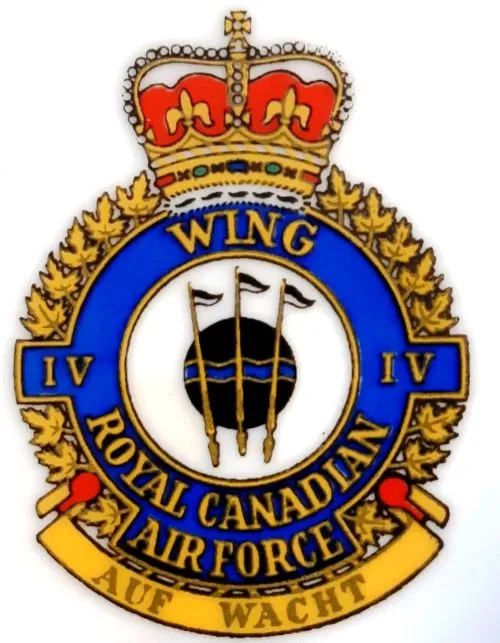
No. 4 (F) Wing, Baden-Soellingen, 1953-1993
No. 414 Squadron RCAF
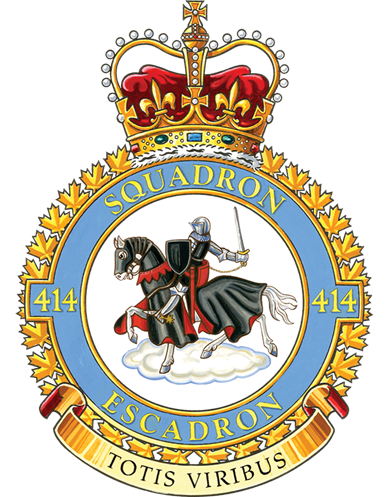
On 13 August 1941, No. 414 Army Co-operation Squadron was formed at RAF Croydon, England, flying Westland Lysander and Curtiss P-40 Tomahawk aircraft. On 28 June 1943 the squadron's name was changed to 414 Fighter Reconnaissance Squadron to reflect its role. During the Second World War the squadron was based at numerous airfields in England and in continentental Europe flying Supermarine Spitfires and North American P-51 Mustang fighters. During this period, the squadron provided photo reconnaissance, intelligence and ground attacks for both the Dieppe Raid and the allied Invasion of Europe. It accounted for 29 enemy aircraft destroyed and 11 damaged, 76 locomotives and 12 naval vessels destroyed. After the war ended, the squadron disbanded at Lüneburg, Germany on 7 August 1945.
Unofficially formed as No. 14 (Photographic) Squadron at RCAF Station Rockcliffe, Ontario on 12 June 1944 and officially renumbered No. 414 Squadron on 1 April 1947. The squadron flew the Douglas CC-129 Dakota to photograph 323,754 square miles (838,520 km2) of Canada's North. When this task was completed it was disbanded on 1 November 1950.
No. 414 Fighter Squadron was reformed as a fighter unit at RCAF Station Bagotville, Quebec, on 1 November 1952. The following summer on 24 August 1953 as part of "Leap Frog IV" the squadron moved to 4 (F) Wing, Baden-Soellingen, Germany The squadron flew Sabre Mk. 4s from Nov 1952 to Nov 1953, Sabre Mk. 5s from Nov 1953 to Aug 1955, and Sabre Mk. 6s from July 1955 to Jul 1957. On 14 July 1957 the squadron was disbanded to make room for the arrival of No. 419 Squadron flying the Avro CF-100 Canuck.
On 5 August 1957, the squadron was reformed at RCAF Station Norh Bay, Ontario, where it operated as an all-weather fighter squadron flying the CF-100 Canuck and the McDonnell CF-1-1 Voodoo until 30 June 1964 when it was disbanded once more. The squadron was reformed on 15 September 1967 at RCAF Station St. Hubert, Quebec in its new role as an electronic warfare squadron flying the CF-100. In August 1972 the squadron moved to CFB North Bay where it remained for the next twenty years flying the CF-100, Boeing CC-117 Globemaster and EF-101. In 1992 the squadron was split into two parts with one part going to CFB Comox, BC as No. 414 Composite Squadron and the other part going to Greenwood, Nova Scotia, as 434 Composite Squadron. In 1993 the squadron changed its name to No. 414 Combat Support Squadron when it was equipped with the Canadair CT-133 Silver Star. The Squadron was disbanded in 2002 when its duties were contracted out to a civilian company.
On 7 December 2007 approval was received for the squadron to stand up again, this time as 414 EWS (Electronic Warfare Support) Squadron. Flying from 3 Wing Bagotville, the squadron is based in Ottawa and is composed of military Electronic Warfare Officers who fulfill the combat support role, flying on civilian contracted aircraft. The squadron was re-formed at Gatineau Airport, Quebec, on 20 January 2009 to operate the Dassault/Dornier Alpha Jet provided by Discovery Air Defence Services.

(DND Photo via James Craik)
Canadair F-86 Sabre Mk. 5 (Serial No. 23063), No. 414 Squadron, coded AQ.

(RCAF Photo via James Craik)
Canadair F-86 Sabre, No. 414 Squadron, coded AQ, RCAF Station Val d'Or, Quebec, 8 July 1953.

(RCAF Photo via James Craik)
Canadair F-86 Sabre, No. 414 Squadron, coded AQ, RCAF Station Val d'Or, Quebec, 8 July 1953.

(DND Photo via James Craik)
Canadair F-86 Sabre Mk. 6 (Serial No. 23416), No. 414 Squadron, coded AQ.
No. 416 Squadron RCAF
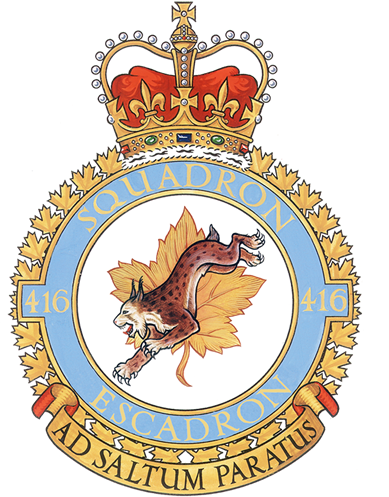
No. 416 Squadron RCAF was formed at RAF Peterhead, Aberdeenshire, Scotland in 1941 as a fighter squadron for service during the Second World War and was based at various RAF stations in Scotland, England and continental Europe. The squadron was disbanded in March 1946.
No. 416 Squadron was reformed at RCAF Station Uplands in Ottawa, Ontario, on 8 Jan 1951, initially flying Mustang Mk. IVs and then Sabres. It was deployed to 2 (Fighter ) Wing at RCAF Station Grostenquin, France, for operations in Europe as part of Canada's Cold War presence. the squadron flew Sabre Mk. 2s from Mar 1952 to Mar 1954, Sabre Mk. 5s from Mar 1954 to May 1955, and Sabre Mk. 6s from Apr 1955 to Jan 1957.
By 1957, the squadron was deactivated on 31 Jan 1957 and reactivated as an All Weather (Fighter) squadron at RCAF Station St. Hubert flying the Avro CF-100 Canuck. This unit was deactivated on 1 Sep 1961 and subsequently moved to RCAF Station Chatham, New Brunswick in Nov 1951. Reactivated on 1 Jan 1962, the squadron's CF-100s were replaced with the McDonnell CF-101 Voodoo, flying the interceptor until the end of 1984. 416 Squadron thus became the world's last front-line unit flying Voodoos.
In 1988 the squadron relocated to CFB Cold Lake, Alberta as a Tactical Fighter Squadron flying McDonnell CF-188 Hornet fighters and later merged with 441 Tactical Fighter Squadron to reform 409 Tactical Fighter Squadron in 2006. The squadron's nickname was City of Oshawa, Lynx.
%2520Wing%2520Grostenquin.avif)
(RCAF Photo)
Canadair F-86 Sabre Mk. 5, RCAF (Serial No. 19250), No. 416 Squadron, coded AS, at No. 2 (F) Wing, RCAF Station Grostenquin, France, 1953.

(CFJIC DND Photo via Don Smith)
Canadair F-86 Sabre Mk. 5, RCAF (Serial No. 19301), AETE, coded PX, “Polar Bear” nose art, undergoing cold weather testing and evaluation connected to AETE at RCAF Station Cold Lake, Alberta.

(RCAF Photo)
Canadair F-86 Sabre Mk. 2, RCAF (Serial No. 19338), 2 (F) Wing, No. 416 Squadron, coded AS, at No. 2 (F) Wing, RCAF Station Grostenquin, France, 1953.

(DND Photo via James Craik)
Canadair F-86 Sabre Mk. 5 (Serial No. 231256, No. 416 Squadron, coded AS, Exercise Carte Blanche, June 1955.

(DND Photo via James Craik)
Canadair F-86 Sabre Mk. 6 (Serial No. 23632), 416 Squadron, coded AS.
No. 421 Squadron RCAF
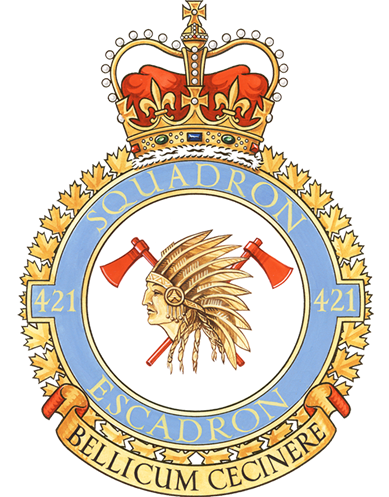
Formed at Digby, Lincolnshire in England on 9 Apr 1942, No. 421 Squadron was the last RCAF fighter squadron to be formed in the UK during the Second World War. Initially equipped with Supermarine Spitfire Mk. VA, the squadron moved to RAF Fairwood Common in May and received the Spitfire Mk. VB. The squadron's motto was Bellicum cecinere ("They have sounded the war trumpet"). Its badge was, in front of two tomahawks in saltire, a Red Indian warrior. During 1942 the squadron was under 10 Group and flew its missions from RAF Warmwell, RAF Bolt Head, RAF Ibsley, RAF Zeals and RAF Charmy Down. In January 1943 the squadron joined No. 127 (Canadian) Wing and moved to Redhill Aerodrome airfield. Late in the spring of 1943 the squadron received the Spitfire Mk. IX and flew under the command of Wing Commander Johnnie Johnson.
In preparation for the Normandy landings, No. 127 Wing was assigned to RAF Second Tactical Air Force. On 16 June 1944, the squadron, along with the other squadrons of No. 127 Wing, was the first to be moved to Normandy and flew air superiority missions. After the allied breakout and quick advance towards the Reich, No. 421 Squadron was based in Evere, Belgium by October 1944. During December 1944 the squadron received the Spitfire Mk. XIV. In 1945 the unit participated in the liberation of the Netherlands, before moving into Germany. At the end of the war the unit had achieved over 90 aerial victories. The squadron was disbanded at Utersen, Germany on 10 Jul 1945.
No. 421 Squadron was reactivated as a Fighter unit at RCAF Station Chatham, New Brunswick on 15 Sep 1949. The squadron initially flew de Havilland Vampire fighters from bases in the UK for operational training with the RAF. In Dec 1951 the squadron was re-equipped with Sabres and joined No. 2 (Fighter) Wing at RCAF Station Grostenquin, France.
The squadron flew Sabre Mk. 5s from Mar 1954 to Jun 1956, and Sabre Mk. 6s from Jun 1956 to Jul 1963.
The squadron was deactivated on 1 Aug 1963 and was reactivated as a Strike Attack squadron on 21 Dec 1963. When 2 Wing was disbanded in Feb 1964, the squadron moved to 4 Wing at Baden-Soelligen, Germany. The |Squadron was equipped with Canadair CF-104 Starfighters and in 1967 the squadron moved to Zweibrücken, West Germany, becoming part of 1 Air Division RCAF (later renamed 1 Canadian Air Group) based at CFB Baden-Soellingen, West Germany. During the early 1980s it was equipped with McDonnell CF-188 Hornets. At the end of the Cold War, the squadron was disbanded and its aircraft and personnel returned to Canada.
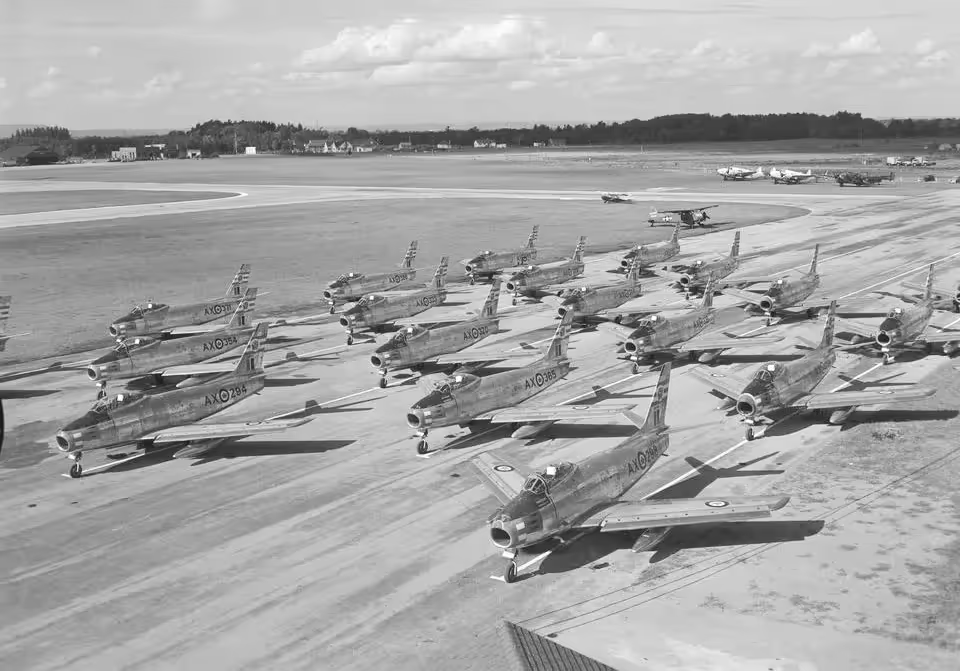
(RCAF Photo)
No. 421 Squadron Sabres just prior to their deployment to Europe.

(DND Photo via James Craik)
Canadair F-86 Sabre Mk. 6 (Serial No. 23648), 421 Squadron, coded AX.

(DND Photo via James Crail)
Canadair F-86 Sabre, No. 421 Squadron, coded AX, view of armament panel, RCAF Air Weapons Unit, Decimomannu, Sardinia.
No. 422 Squadron RCAF
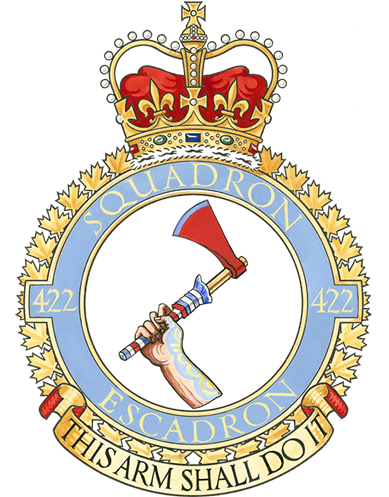
No. 422 General Reconnaissance Squadron was initially formed at RAF Castle Archdale near Lough Erne, Northern Ireland, on 2 April 1942. It was a flying-boat squadron, flying Consolidated PBY Catalinas and Short Sunderlands to patrol the North Atlantic for German U-boats. They were redesignated as a Transport Squadron in June 1945, and disbanded on 3 Sep 1945.
The squadron was reformed at RCAF Station Uplands, near Ottawa on 1 Jan 1953 as No. 422 Fighter Squadron. The squadron went to 4 (Fighter) Wing based at RCAF Station Baden-Soellingen, Germany, in August 1953. The squadron flew Sabre Mk. 2s from Jan to May 1953, Sabre Mk. 4s from Apr 1953 to Dec 1954, Sabre Mk. 5s from Jan to Sep 1955, and Sabre Mk. 6s from Sep 1955 to Apr 1963.
The Squadron was deactivated on 15 Apr 1963 and reactivated as a Strike Attack unit on 15 July 1963. It was based at 4 (F) Wing until its deactivation in July 1970.
The squadron was reactivated as 422 Tactical Helicopter Squadron in January 1977, and remained a helicopter squadron until it was disbanded again in August 1980.

(DND Archives Photo, PL-55764)
Canadair F-86 Sabre, No. 422 Squadron, having its six .50 cal machine guns harmonized at night at RCAF Station Uplands in 1953. The procedure ensures that all six machine-guns are aimed properly.

(DND Photo via James Craik)
Canadair F-86 Sabre Mk. 5 (Serial No. 23140), No. 930, F/O J.S. Randle, No. 422 Squadron.

(DND Photo via Mike Raymond Semrau)
Canadair F-86 Sabre Mk. 5 (Serial No. 23019), likely at the manufacturer's facility at Cartierville, near Montreal. First flown on 6 November 1953, this Sabre served with No. 422 "Tomahawk" Squadron at 4 (F) Wing, Baden-Soellingen, Germany. It was withdrawn from service on 26 May 1960.

(James Craik Photo)
Canadair F-86 Sabre Mk. 6 (Serial Nos. 23667, 23723, 23730, 23742, 23721 and 23720), 422 Squadron, Sardinia, ca 1960-61.

(DND Photo via James Craik)
Canadair F-86 Sabre Mk. 6 (Serial No. 23721), No. 422 Squadron in front of the maintenance hangar at 4 Wing.

(DND Photo)
Canadair F-86 Sabre Mk. 6 (Serial No. 23499) of No. 422 Squadron, Norway, 1963.

(422 Potpouri Photo)
Canadair F-86 Sabre Mk. 6 (Serial No. 23392), No. 422 Squadron, coded TF.

(DND Photo via James Craik)
Canadair F-86 Sabre Mk. 6 (Serial No. 23520), No. 422 Squadron, leaving the dispersal area for the last time.

(DND Photo via James Craik)
Canadair F-86 Sabre Mk. 6, No. 422 Squadron, leaving the dispersal area for the last time.
%252C%2520422%2520Squan%252C%2520Decimomannu.avif)
(DND Photo)
Canadair F-86 Sabre Mk. 6 (Serial No. 23466), No. 422 Squadron, possibly being serviced in Decimomannu, Sardinia.
No. 427 Squadron RCAF
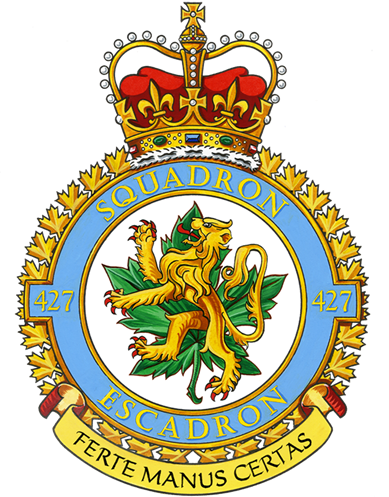
No. 427 Squadron flew out of No. 3 (Fighter) Wing at Zweibrücken, Germany, in March 1953. The squadron flew Sabre Mk. 2s from Sep 1952 to Jun 1953, Sabre Mk. 5s from May 1953 to Sep 1955, and Sabre Mk. 6s from Sep 1955 to Dec 1962. The Squadron was selected as the first European RCAF squadron to receive the Canadair CF-104 Starfighter in the nuclear strike role. The squadron was stood down from its day-fighter role on 15 December 1962 and reformed as 427 (Strike-Attack) Squadron two days later. The squadron was again disbanded on 1 July 1970. No. 427 Squadron was reformed as 427 Tactical Helicopter Squadron at CFB Petawawa, Ontario, where it continues to serve.

(RCAF Photo)
Canadair F-86 Sabre Mk. 2 (Serial No. 19423), No. 427 Squadron, 3 (F) Wing, Zweibrücken, Germany, 1954.

(RCAF Photo, PC-196)
Canadair F-86 Sabre Mk. 2 (Serial No. 19427), No. 427 Squadron, 13 Feb 1953.

(DND Photo via James Craik)
Canadair F-86 Sabre Mk. 2 (Serial No. 19451), St Hubert, No. 427 Squadron, ready for Leapfrog 3.

(LCol (ret’d) Syd Burrows Photo)
Canadair F-86 Sabre with the No. 1 RCAF Air Division aerobatic team, the Fireballs, in 1954 at No. 3 (F) Wing, Zweibrucken, Germany. From left to right: S/L Chuck Keating (lead), F/O Rick Mace, F/O Syd Burrows and F/O Jack Frazer. It should be noted that the Fireballs flew Mk. 2 Sabres, this is a Mk. 5 (Serial No. 23153).

(DND Photo via James Craik)
Canadair F-86 Sabre Mk. 2, No. 427 Squadron.

(James Craik Photo)
Canadair F-86 Sabre Mk. 2, No. 427 Squadron, with blast residue on gun port, Morocco.

No. 4 (F) Wing, Baden-Soellingen, 1953-1993

(DND Photo via James Craik)
Canadair F-86 Sabre (Serial No. 23421), No. 444 Squadron,coded VH, No. 4 (F) Wing, Baden-Soelligen, being serviced ca 1950s.Photo via James Craik)
No. 430 Squadron RCAF
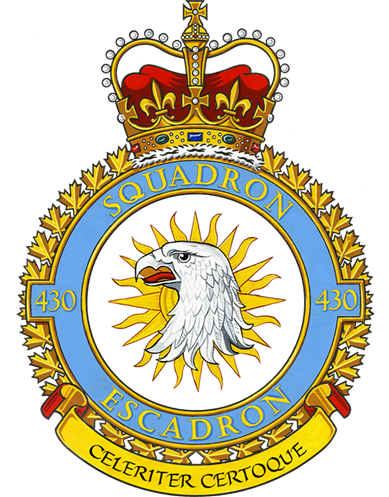
No. 430 Squadron RCAF was formed during the Second World War as the "City of Sudbury" squadron in 1943. Initially created as an army co-operation squadron, 430 Squadron was redesignated as a fighter reconnaissance unit later that year. The unit was stationed in England, France, Belgium, the Netherlands, and Germany, and flew photo reconnaissance missions in support of planning for the Normandy landings. After D-Day, missions included before-and-after photography of attacks on V-1 flying bomb launch sites and support for ground forces. 430 Squadron was disbanded in Germany in August 1945.
In the Cold War period, the squadron was reformed in November 1951 at RCAF Station North Bay, Ontario, flying the Canadair F-86 Sabre, on 1 Nov 1951. It was given the nickname Silver Falcon. No. 430 Fighter Squadron went to 2 (F) Wing RCAF Station Grostenquin, France, in September 1952. The squadron was located at Grostenquin until deactivation in September 1962. The squadron flew Sabre Mk. 2s from Nov 1951 to Jun 1953, Sabre Mk. 5s from Jun 1953 to Jun 1957, and Sabre Mk, 6s from May 1957 to May 1963.
No. 430 Fighter Squadron was reactivated at 3 (F) Wing, Zweibrücken, Germany, in February 1963, and transitioned to the Canadair CF-104 Starfighter. The squadron moved to No. 1 (F) Wing, Lahr, Germany, in February 1969 until it was disbanded in May 1970.
The unit reformed again in 1971 as a French-language CF tactical helicopter squadron at CFB Valcartier, Quebec, and known officially as 430e Escadron tactique d'hélicoptères. There it operated the Bell CH-136 Kiowa helicopter, and the Bell CH-135 Twin Huey helicopter in support of 5 Canadian Mechanized Brigade Group. The unit transitioned to the Bell CH-146 Griffon helicopter in 1994.

(DND Photo)
Canadair F-86 Sabre Mk. 6s of No. 430 Squadron, on Zulu alert at 2 (F) Wing, RCAF Station Grostenquin, France, June 1960.

(DND Photo via James Craik)
1 Canadian Air Division formation flight, Canadair CF-104 Starfighter (Serial No. 12797) with Avro CF-100 Canuck Mk. 4B (Serial No. 18444), of No. 423 Squadron, Canadair CT-133 Silver Star (Serial No. 585), and Canadair F-86 Sabre (Serial No. 23586), of No. 430 Squadron, 2 (F) Wing, Grostenquin, France.

(DND Photo)
Canadair F-86 Sabre Mk. 6 (Serial No. 23440). No. 430 Squadron, over Germany, ca 1950s.
No. 431 Squadron RCAF
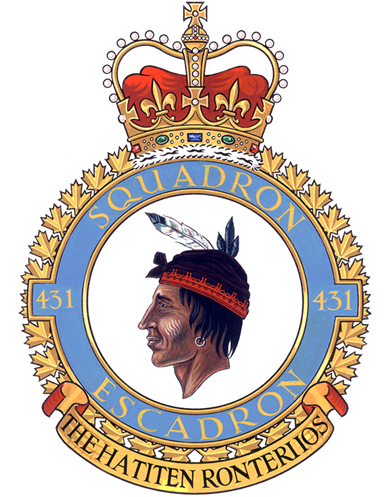
18 Jan 1954. No. 431 (Fighter) Squadron was re-formed at Bagotville, Quebec, flying the Canadair F-86 Sabre Mk. 2. The squadron was formed on a temporary basis until there were enough new Avro CF-100 Canuck fighters available to fulfill RCAF squadron needs. No. 431 (Fighter) Squadron's duties included aerial combat training and displaying the capabilities of jet operations to the public at air shows, the largest being Operation Prairie Pacific: a 50-minute exhibition with aircraft from several squadrons that travelled to selected locations across western Canada. The team from No. 431 Squadron consisted of four Sabres and a solo aircraft. This was the first Sabre team to be authorized to perform formation aerobatics in Canada. The squadron was disbanded on 1 Oct 1954.

(RCAF Photo via James Craik)
Canadair F-86 Sabre Mk. 2 (Serial No. 19102), No. 431 Squadron, with Fern Villeneuve, RCAF Station Bagotville, Quebec, 1954.

(RCAF Photo via James Craik)
Three Canadair F-86 Sabre Mk. 2, No. 431 Squadron, RCAF Station Bagotville, Quebec, 1954.

(RCAF Photo via James Craik)
Canadair F-86 Sabre Mk. 2 flight line photo with six RCAF members of No. 431 Squadron, RCAF Station Bagotville, Quebec, 1954.

(RCAF Photo via James Craik)
Canadair F-86 Sabre Mk. 2 flight line, No. 431 Squadron, RCAF Station Bagotville, Quebec, 1954.
No. 434 Squadron RCAF
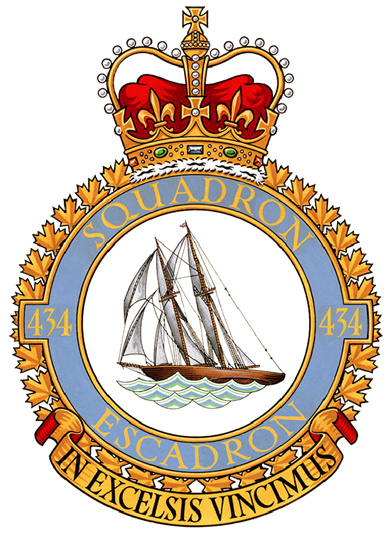
No. 434 Squadron was first formed at RAF Tholthorpe in the UK, on 13 June 1943, flying the Handley Page Halifax Mk. V bomber. On 13 August 1943 it flew its first operational sortie, a bombing raid across the Alps to Milan, Italy. In May 1944 the unit received Halifax Mk. IIIs to replace its Mk. Vs. The squadron was adopted by the Rotary Club of Halifax, Nova Scotia, and to show its connection to the city adopted the nickname "Bluenose Squadron", the common nickname for people from Nova Scotia and a tribute to the schooner Bluenose. An image of the schooner appeared on the squadron badge.
The squadron moved to RAF Croft in December 1943 and re-equipped with Avro Lancaster Mk. Is and Mk. Xs in December 1944. After VE Day, the squadron was earmarked for Tiger Force to carry on the war against Japan, but was never deployed to the Far East. The unit was disbanded at Dartmouth, Nova Scotia, on 5 September 1945.
During the Second World War, the unit flew 198 missions, including 179 bombing, 17 mine laying, one diversionary and one sea search. This was made up of a total of 2,582 individual aircraft sorties, including 45 prisoner of war airlift sorties. It flew 14,622 operational flying hours and dropped 10,358 tons of bombs plus 225 mines. The squadron accounted for seven enemy aircraft destroyed along with two probable and four damaged. 434 Squadron suffered 75 aircraft lost, 484 aircrew operational casualties, including 34 killed, 313 presumed dead, 121 made prisoners and 16 who evaded capture and escaped. The non-operational casualty total was eight killed, plus one member who died of natural causes. Unit personnel received six bars to the DFC, 108 DFCs, six DFMs, one BEM and seven MiDs.
The squadron was reformed flying the Canadair F-86 Sabre and stationed as part of 3 (F) Wing at RCAF Station Zweibrücken, Germany, on 7 March 1953, but was stood down on 16 June 1962. During this period, the squadron flew Sabre Mk. 2s from Jul 1952 to Nov 1953, Sabre Mk. 5s from Oct 1953 to Jan 1957, and Sabre Mk, 6s from Jan 1957 to Jan 1963.
It was re-activated on 8 April 1963 as a Canadair CF-104 Starfighter unit in the strike/attack role and disbanded again on 1 March 1967. No. 434 Operational Training Squadron (OTU) formed at CFB Cold Lake, Alberta as the Canadair CF-116 Freedom Fighter operational training unit on 15 February 1968. The squadron later gave up OTU duties to 419 Squadron and became an operational squadron, moving to CFB Bagotville, Quebec on 15 July 1982 later moving to CFB Chatham, New Brunswick, in July 1985.

(DND Photo via James Craik)
Canadair F-86 Sabre Mk. 6 (Serial No. 23752), No. 434 Squadron, coded BR.

(James Craik Photo)
Canadair F-86 Sabre pilots, No. 434 Squadron, Sardinia, 1960-61.

(James Craik Photo)
Canadair F-86 Sabre, ground crew, Sardinia, ca 1961.

(DND Photo via James Craik)
Canadair F-86 Sabre Mk. 6 (Serial No. 23707), No. 434 Squadron.

(DND Photo via James Craik)
Canadair F-86 Sabre Mk. 6 (Serial No. 23466). No. 434 Squadron deployed to 2 (F) Wing, Grostenquin, France, in the summer of 1962. The runways at 3 (F) Wing were closed to prepare for the arrival of the Canadair CF-104 Starfighters. The Sabres were flown from there to Preswick in the UK for disposal.
No. 438 Squadron RCAF
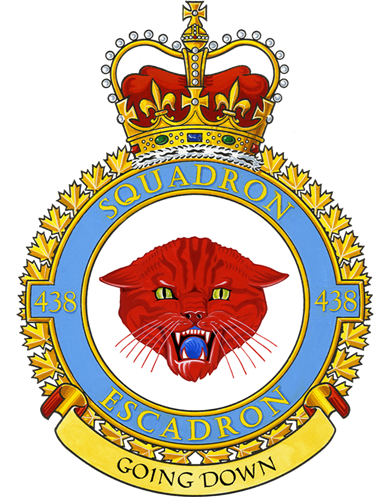
No. 438 "City of Montreal" Squadron (Auxiliary) was formed at Montreal, Quebec on 15 Apr 1946. The squadron flew de Havilland Vampire and Canadair F-86 Sabre fighters until Nov 1958 when it was reassigned to a light transport and emergency rescue role. The Squadron flew Sabre Mk. 5s from Oct 1956 to Nov 1958.

(No. 438 Squadron Archives Photo, via Francois Dutil)
Canadair F-86 Sabre Mk. 5s, No. 438 Squadron, coded BQ, RCAF Station St-Hubert, Quebec, 1958.

(No. 438 Squadron Archives Photo, via Francois Dutil)
Canadair F-86 Sabre Mk. 5 (Serial No. 23110), No. 438 Squadron, coded BQ.
No. 439 Squadron RCAF

No. 439 Squadron was formed in Canada on 15 Jan 1942 as No. 123 (Army Co-operation) Squadron for army training operations in eastern Canada during the Second World War. It was being renumbered No. 439 Squadron RCAF in late 1943 when it transferred to England. The squadron briefly flew Hawker Hurricane fighters before receiving the Hawker Typhoon. It flew ground attack missions with the Second Tactical Air Force (2nd TAF) in support of the Allied advance in northwestern Europe from mid-1944 to the end of the war in May 1945. The squadron was disbanded at Flensburg, Germany on 26 Aug 1945.

(RCAF Photo via Jack Jack Fortin)
Canadair F-86 Sabre Mk. 2s (Serial No. 19204), No. 439 Squadron, lined up in the early morning English fog at 1 (Fighter) Wing at RCAF Station North Luffenham, Rutland, UK, with an eleven-fighter flypast overhead, c1952.
No. 439 Squadron was reformed at RCAF Station Uplands, Ontario on 1 Sep 1951 as a Fighter unit operating the Canadair F-86 Sabre. It joined No. 1 (Fighter) Wing at North Luffenham, Nottinghamshire, England in June 1952. Early in 1955 the squadron moved to Marville, France until it was deactivated on 1 Nov 1963. The squadron flew Sabre Mk. 2s from Nov 1951 to Feb 1955, Sabre Mk. 5s from Mar 1955 to Jul 1956, and Sabre Mk. 6s from Jul 1956 to Oct 1963.
The squadron was reformed as No. 439 Reconnaissance/Attack Squadron, operating the Canadair CF-104 Starfighter. After moving to Germany in 1967, No. 439 Squadron underwent several redesignations before assuming a ground attack mission at CFB Baden-Soellingen as No. 439 Tactical Fighter Squadron. After converting to the McDonnell CF-188 Hornet fighter in the mid-1980s, the squadron participated in the Gulf War. It assumed its current title in 1993, operating the Bell CH-146 Griffon helicopter.

(DND Photo via James Craik)
Canadair F-86 Sabre Mk. 5, (Serial No. 23352), No. 439 Squadron, with Exercise Carte Blanch markings applied.
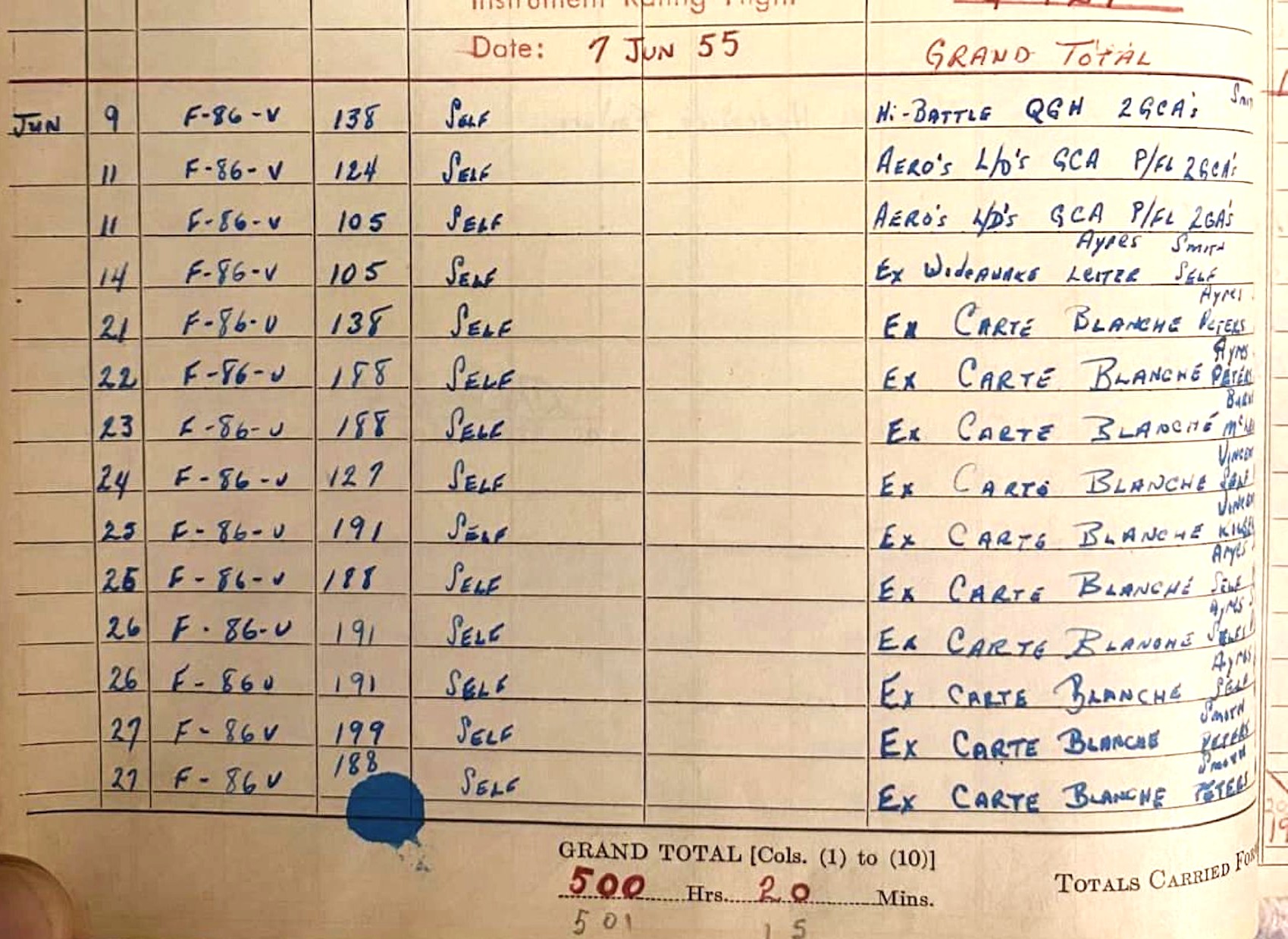
(James Craik Photo)
Exercise Carte Blanche logbook, James Craik, 7 June 1955.

(RCAF Photo via Mike Kaehler)
Canadair F-86 Sabre Mk. 5 (Serial No. 23347), No. 439 Squadron, coded IC.
One of the basic rules of flight-line safety, that has been in effect for many years, is that you cannot put fuel and oxygen into an aircraft at the same time. You can clearly see the oxygen cart at the front of the aircraft with one tech connecting the oxygen line to the forward fuselage while a fuel bowser sits at the rear of the aircraft with another tech fuelling the aircraft. A dangerous situation that no one in this photo seems to be concerned with. (Mike Kaehler)
23345 was taking part in a major NATO Exercise Carte Blanche, which involved 3,000 aircraft. The exercise was held 20-28 June 1955. 12 RCAF squadrons from No. 1 Air Division participated. The purpose of the exercise was to test NATO's response to a Soviet and Warsaw Pact attack on the west.

(DND Photo, PL-82288, via James Craik)
Canadair CL_13 Sabre Mk.5s, (Serial Nos. 23358, and 23347).


(RCAF Photo)
Canadair F-86 Sabres, No. 439 Squadron, with a Canadair CL-2 North Star at RCAF Station Bagotville, Quebec, on the first stop on a crossing to England.

(DND Photo via James Craik)
Canadair F-86 Sabre Mk. 2, No. 439 Squadron, BW-1 airfield, Narsarssuak Air Base, Southern Greenland.

(RCAF Photo)
Canadair F-86 Sabre Mk. 2 (Serial No. 19188), No. 439 Squadron, ca 1952.

(RCAF Photo via James Craik)
CanadairF-86 Sabre Mk. 2 (Serial No. 19187), No. 439 Squadron, with a USAF Boeing B-17 Flying Fortress in the background, ca 1952.

(Library and Archives Canada Photo, MIKAN No. 3584682)
Canadair F-86 Sabre Mk. 2 (Serial No. 19187), No. 439 Squadron, 20 June 1952.

(DND Archives Photo, PC-81)
Canadair F-86 Sabres, No. 439 Squadron, lined up on the tarmac at RCAF Station Uplands, Ottawa, Ontario.

(DND Photo via James Craik)
Canadair F-86 Sabre Mk. 6 (Serial No. 23470), No. 439 Squadron, coded IG, being off-loaded at RCAF Station Trenton, Ontario, to join the Golden Hawks in the fall of 1960.
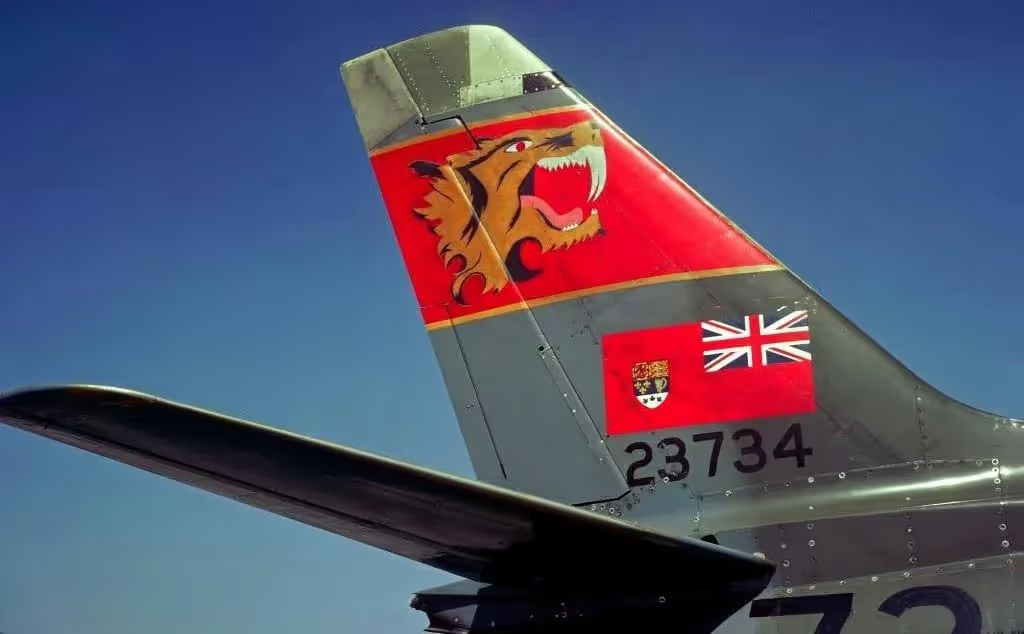
(DND Photo via James Craik)
Canadair F-86 13 Sabre Mk. 6 (Serial No. 23734), No. 439 Squadron colours.

(DND Photo via James Craik)
Canadair F-86 Sabre Mk. 6 (Serial No. 23469), No. 439 Squadron.
No. 441 Squadron RCAF
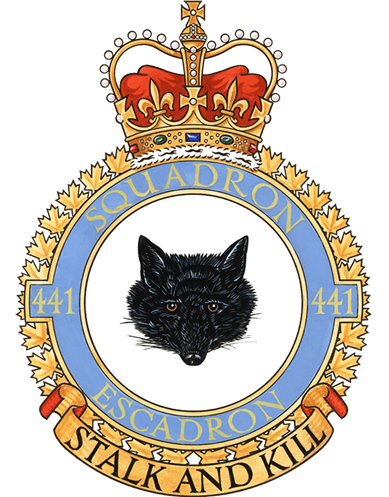
No. 125 (Fighter) Squadron was formed on 20 April 1942 at Sydney, Nova Scotia and flew Hawker Hurricanes as part of RCAF Eastern Air Command. It was renumbered No. 441 Fighter Squadron when it transferred overseas to RAF Station Digby, Lincolnshire, England, on 8 February 1944. The Squadron was posted to airfields in England, France, and Belgium throughout the Second World War, flying the Supermarine Spitfire. When the squadron returned to England it was disbanded on 7 August 1945.
No. 1 (F) Wing, Canada's first NATO fighter wing, was initially located at North Luffenham, England since its French base was not ready. The first of the wing's three fighter squadrons (all squadrons flying Canadair F-86 Sabres), No. 410 Squadron, arrived at North Luffenham in November 1951. The squadron and its aircraft, along with those of No. 441 Squadron, were ferried across the Atlantic to Glasgow, Scotland aboard HMCS Magnificent. The personnel of No. 441 Squadron arrived by ocean liner in February 1952. In May–June 1952, No. 439 Squadron flew from RCAF Station Uplands via Bagotville, Goose Bay, Greenland, Iceland and Scotland, in an exercise known as “Operation Leapfrog”.
No. 441 Squadron reformed at RCAF Station St. Hubert, Quebec, on 1 March 1951 and went to No. 1 (F) Wing, then located at RAF North Luffenham, in Rutland, England on 13 February 1952. The squadron was temporarily situated at 3 (F) Wing Zweibrücken on 21 December 1954, before moving to their intended destination, RCAF Station Marville, France. The Squadron was disbanded on 1 September 1963 at Marville. The squadron flew Sabre Mk. 2s from Jun 1951 to Jun 1953, Sabre Mk. 5s from Jan 1955 to Aug 1956, and Sabre Mk. 6s from Aug 1956 to Sep 1963.
No. 441 Squadron was reformed on 15 Sep 1963 for the Strike/Reconnaissance role and equipped with the Canadair CF-104 Starfighter. The Squadron then moved with No. 1 (F) Wing to CFB Lahr, Germany, in April 1967. In 1971 the squadron moved to CFB Baden-Soellingen and changed its name to 441 Tactical Fighter Squadron. They disbanded again in 1986 and then finally reformed at 4 Wing Cold Lake, Alberta, on 26 June 1986.
On 6 July 2006, No. 441 Squadron was once again disbanded. The Squadron's crew amalgamated with 416 Tactical Fighter Squadron at CFB Cold Lake, Alberta, and re-formed as 409 Tactical Fighter Squadron. The squadron's colours and battle honours were placed in Sydney, Nova Scotia, where it first operated.

(DND Photo)
Canadair F-86 Sabre Mk. 2 (Serial No. 19274), flying from RAF North Luffenham, England, before transferring to No. 1 (F) Wing, Marville, France.

(DND Photo)
Canadair F-86 Sabre Mk. 2 (Serial No. 19274), flying from RAF North Luffenham, before transferring to No. 1 (F) Wing, Marville, France.

(DND Photo)
Canadair F-86 Sabre Mk. 2 (Serial No. 19274), flying from RAF North Luffenham, before transferring to No. 1 (F) Wing, Marville, France.

(RCAF Photo via Jack Jack Fortin)
Canadair F-86 Sabre Mk. 2 (Serial No. 19165), (Serial No. 19152), (Serial No. 19162), (Serial No. 19146) coded BT, in formation, No. 441 Squadron, North Luffenham, England.

(SDASM Photo)
Canadair F-86 Sabre Mk. 2 (Serial No. 19152), No. 441 Squadron, coded BT.

(RCAF Photo via Mike Kaehler)
Canadair F-86 Sabre Mk. 2 (Serial No. 19150), coded BT-A, No. 441 Squadron, North Luffenham, England. The aircraft is being prepared for a launch. The pilot is climbing aboard and technicians are applying ground power for the start.

(DND Photo via James Craik)
Canadair F-86 Sabre Mk. 2 (Serial No. 19127), No. 441 Squadron, coded BT.

(DND Photo via James Craik)
Canadair F-86 Sabre Mk. 6 (Serial No. 23659), No. 441 Squadron, coded BT, 4 (F) Baden-Soellingen, Germany.

(DND Photo via Mike Paradie)
Canadair F-86 Sabre Mk. 5 (Serial No, 23017), No. 441 Squadron, coded BT.

(DND Photo via James Craik)
Canadair F-86 Sabre Mk. 6 (Serial No. 23650), No. 441 Squadron, 4 (F) Baden-Soellingen, Germany.

(RCAF Photo via Mike Kaehler)
Canadair F-86 Sabre Mk. 5 (Serial No. 23004), No. 441 Squadron, coded BT. General view of a ground crew team consisting of Armourers, Riggers, Fitters, Instrument Mechanics working on a "Silver Fox" Squadron Sabre at No. 1 (F) Wing in Marville, France (Note the fox on the left forward fuselage). This aircraft went on to the West German Air Force in 1957.
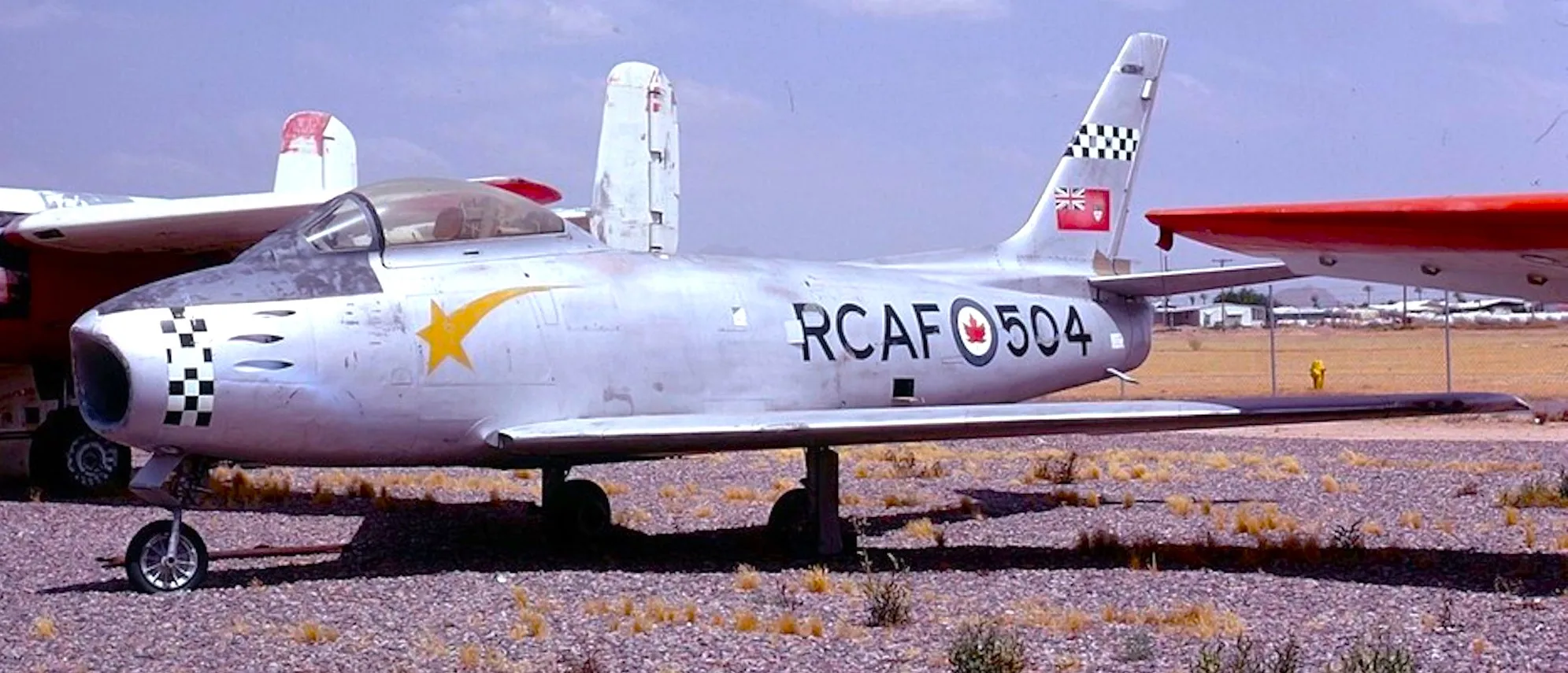
(eBay Photo via James Craik)
Canadair LC-13 Sabre Mk. 6 (Serial No. 23504), No. 441 Squadron, Falcon Field, Arizona, c1970s.
No. 442 Squadron RCAF
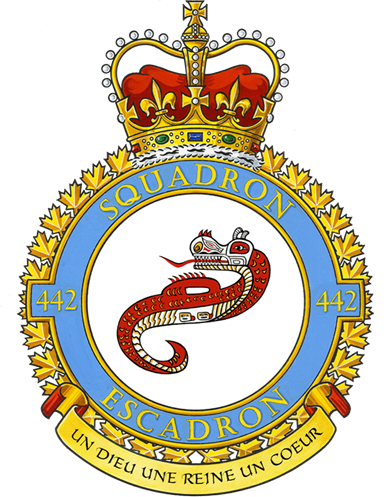
No. 442 "City of Vancouver" Squadron (Auxiliary), coded SL,was formed at Vancouver, British Columbia on 15 Apr 1946, flying de Havilland Vampire, North American Mustang Mk. IV and Canadair F-86 Sabres until Oct 1958, when the unit was reassigned to a light transport and emergency rescue role. The squadron flew Sabre Mk. 5s from Aug 1956 to Aug 1958.
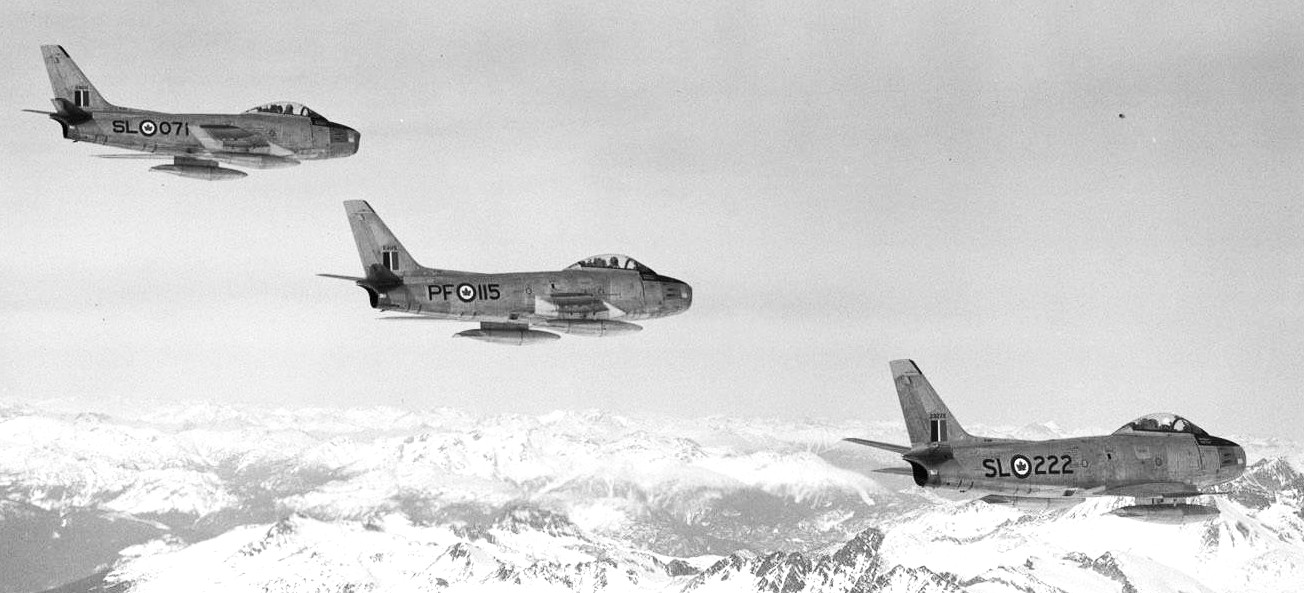
(DND Photo via James Craik)
Canadair F-86 Sabre Mk. 5 formation from Vancouver Auxiliary Squadrons, over the Rockies. (Serial No. 23071), No. 442 Squadron, coded SL, (Serial No. 23115), No. 443 Squadron, coded PF, (Serial No. 23222), coded SL.
No. 443 Squadron RCAF
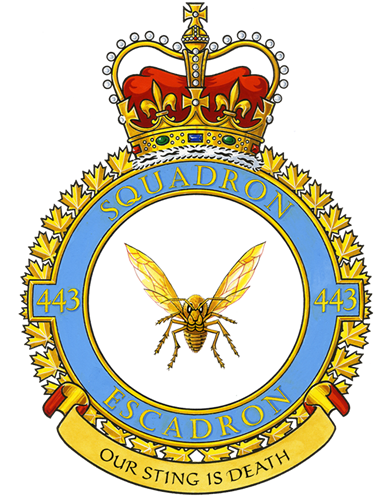
No. 443 "City of New Westminster" Squadron (Auxiliary), coded PF, was formed at Vancouver, British Columbia on 15 Sep 1951, flying de Havilland Vampire, North American Mustang Mk. IV and Canadair F-86 Sabres until Oct 1958, when the unit was reassigned to a light transport and emergency rescue role. The squadron was disbanded on 1 Apr 1964. The squadron flew Sabre Mk. 5s from Aug 1956 to Aug 1958.
No. 444 Squadron RCAF
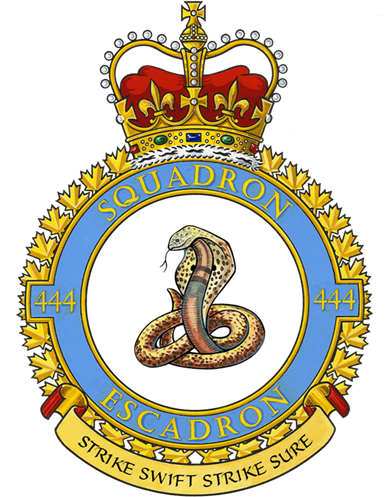
No. 444 Fighter Squadron was formed in March 1953 at RCAF Station St. Hubert, Quebec, and moved to 4 (Fighter) Wing, RCAF Station Baden-Soellingen, Germany, in Sep 1953. The Squadron was deactivated on 1 Mar 1963. The squadron flew Sabre Mk. 4s from Mar 1953 to Mar 1954, and Sabre Mk. 6s from Apr 1955 to Feb 1963. Coded VH.
The squadron was reformed on 27 May 1963 as a Strike/Attack unit flying the Canadair CF-104 Starfighter from 1962 until it was deactivated on 1 Apr 1967.
The unit was re-formed as No. 444 Tactical Helicopter Squadron at CFB Lahr, Germany in 1972 as part of Canadian Forces Europe (CFE) until 1991. No. 444 Squadron flew the the Hiller CH-112 Nomad helicopter from 1961 to 1972, the Bell CH-136 Kiowa from 1972 to 1991 when it was stood down. It stood up again at CFB Goose Bay, Labrador, in 1993, and flew the Bell CH-135 Twin Huey from 1993 to 1996. No. 444 Combat Support Squadron is currently equipped with three Bell CH-146 Griffon helicopters. Its primary mission is to provide rapid response to local emergencies during flight operations and military exercises taking place at 5 Wing. In its utility role the squadron carries out tasks such as range support, search and rescue, and assistance to civil authorities.

(DND Photo via James Craik)
Canadair F-86 Sabre Mk. 4 (Serial No. 19702), No. 444 Squadron, coded VH, A.J. Bauer at the controls.

(F/O Rigby John Stamison Photo, from Paul Stamison via James Craik)
Canadair F-86 Sabre Mk. 4 (Serial No. 19636), No. 444 Squadron, coded VH, at RCAF Station St Hubert, Quebec, prior to Leapfrog IV, September 1953.

(F/O Rigby John Stamison Photo, from Paul Stamison via James Craik)
Canadair F-86 Sabre Mk. 4 (Serial No. 19636), No. 444 Squadron, coded VH, at RCAF Station St Hubert, Quebec, prior to Leapfrog IV, September 1953.

(F/O Rigby John Stamison Photo, from Paul Stamison via James Craik)
F/O Stamison with his Canadair F-86 Sabre Mk. 4 (Serial No. 19659), No. 444 Squadron, coded VH, at RCAF Station St Hubert, Quebec, prior to Leapfrog IV, September 1953.


(DND Photo via James Craik)
Canadair F-86 Sabre Mk. 5 (Serial No. 23045), No. 444 Squadron, coded VH.

(DND Photo via James Craik)
Canadair F-86 Sabre Mk. 5 (Serial No. 23115), No. 444 Squadron, coded VH.

(DND Photo via James Craik)
Canadair F-86 Sabre (Serial No. 23421), No. 444 Squadron, coded VH, No. 4 (F) Wing, being serviced ca 1950s.

(DND Photo via James Craik)
Canadair F-86 Sabre Mk. 6 (Serial No. 23635), No. 444 Squadron, coded VH, undergoing maintenance.

(DND Photo via James Craik)
Canadair F-86 Sabre Mk. 5 (Serial No. 23472), No. 444 Squadron, coded VH, at SAL for overhaul.

(DND Photo via James Craik)
Canadair F-86 Sabre Mk. 5 (Serial No. 23472), No. 444 Squadron, coded VH, in a dispersal area.

(RCAF photo via Fred Paradie)
Canadair F-86 Sabre Mk. 5 (Serial No. 23407), flown by F/O Ray Baltins, No. 444 Squadron, coded AQ, lost 4 July 1962.
There is a brief note in Larry Milberry’s book on the Canadair Sabre that suggests one of our pilots might have “crossed over” with his Sabre. Flying Officer Hagarty, a former Sabre pilot iwth Nos. 413 and 416 Squadrons, had heard a report of a 4-ship flight of Sabres from No. 444 Squadron operating out of 4 (F) Wing, Baden-Söllingen, that was up on a training flight. Ken stated, “One of the Sabre pilots, Flying Officer F. Ray Baltins reported that he had landing gear problems and that he was turning back to base. Flying Officer F.R. Baltins was never heard from again.”
Flying Officer Raimond Baltins (RCAF S/N 134969) was born in Latvia on 4 June 1937. He completed Operational Training Unit (OTU) Course Number 79 at RCAF Station Chatham, New Brunswick (10 August to 31 Dec 1959). F/O Baltins flew with No. 444 Squadron from January 1960 to the time he went missing on 4 July 1962. He was flying Sabre (Serial No. 23407), which was officially struck off strength (SOS) on 11 September 1962.
When he did not return to base and there was no report of a crash, a rumour spread suggesting he might have crossed over. Considering the era, this would have been extremely unlikely, and there is an unconfirmed report that the wreckage of Flying Officer Baltins’ Sabre was later located in the Vosges Mountains in France. Flying Officer Baltins had immigrated to Canada with his parents in 1949. In 1964, his mother created an award for his old Air Cadet Squadron in Montreal, Quebec (Canadair Squadron). His name is listed on the memorial in the airpark at Trenton.
**





